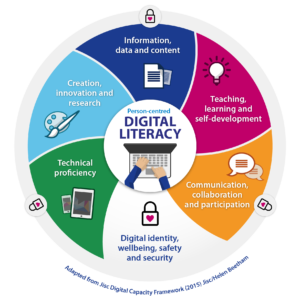What is Digital Literacy?
Digital literacy is relatively new when looking from the point of view of classroom community and the role it plays in constructive learning inside the classroom. Digital Literacy can be defined as “the ability to use information and communication technologies to find, evaluate, create, and communicate information, requiring both cognitive and technical skills.” (Ghosh, 2020) In society today, the reliance on electronic devices in both concerning and seen as an addiction. However, if an educator can harness the power that electronics have over students and turn the attention of the learners from an addictive trance to a beneficial interactive discussion than there are lessons being learned that be taken away from the classroom and be applied to life outside an educational institution.
Digital literacy is important because students need to learn the proper way to sift through information that may be coming from discreditable sources as well as not being caught in social media bubble that may hinder then from finding out who they are as person without technology. Argelagos (2016) highlighted the importance of “structuring the instruction,” (P.51) and how “it is worth highlighting the importance of guiding students through the whole process of information problem resolution.” (P.51) In order to learn how to go through the process of documenting information that is found on the internet, Argelagos (2016) recommends the following three principles:
” (1) embedding the IPS skills in the scholar curriculum to learn the current subjects through meaningful and authentic contents, (2) structuring the students’ problem solving, and (3) supporting the students’ problem resolution by a series of scaffolds to guide the students’ progress.” (P. 51)
In the future classroom I will start the year by speaking to the class about the importance of digital literacy and how I will use multi media components in lessons but also, that there will be lessons dedicated to the importance of finding authentic information through digital learning and have them do activities the require research via search engines. Digital technologies are growing more important by the day which makes “digital literacy essential for progress in the contemporary era.” (Njenga, 2018, P. 1) I believe it is also important to look at digital literacy through a critical lens and come to the realization that there are challenges regarding communities that don’t have access to digital resources and this fact “addresses the ideological concerns and the social and educational inequalities.” (Njenga, 2018, P.2) In many ways, “digital literacy is seen as another way of propagating the already existing digital divide,” (Njenga, 2018, P. 3) between communities and social classes.
The idea of digital literacy as an identify thief of sorts is interesting because not only can it be taken as a literal theft via breach of information but also the concern that as students are still trying to figure out their own identity while influenced by electronics. Burnett (2014) argues that “children may use their reading or writing as an act of identity in complex ways,” (P. 4) and this means they are forging a path for themselves but there is still a struggle to build or regain living versus being told how to live through digital vices.
In previous experiences of my own there is a lot of reliance on the digital world and my one concern when going into my own classroom is the popular trend, “blaming of humans actions on technology which allows humans to escape responsibility for actions which were the results of their own choices.” (Martin, 2008, P. 152) These mistakes in turn build a “life that needs to be constantly active and constantly re-created” (Martin, 2008, P. 154) to provide happiness and content in one’s life.
To conclude, I have included a photo below that I believe perfectly encapsulates the ideas behind digital literacy and one that I will use as inspiration in my future classroom. It shows how digital literacy is a part of everything we do as humans not just inside the classroom.

Digital Literacy Circle (Ghosh, 2020)
Works Cited
Argelagós, E., & Pifarré, M. (2017). Unravelling Secondary Students’ Challenges in Digital Literacy: A Gender Perspective. Journal of Education and Training Studies, 5(1), 42– 55.
Burnett, C. (2014). Investigating pupils’ interactions around digital texts: a spatial perspective on the “classroom-ness” of digital literacy practices in schools. Educational Review, 66(2), 192– 209.
Ghosh, M. (2020, July 25). Digital Literacy – Why is it Important for Teachers in 2020. Retrieved September 22, 2020, from https://www.henryharvin.com/blog/digital-literacy- why-is-it-important-for-teachers/
Martin, A. (2008). Digital literacy and the “digital society”. Digital literacies: Concepts, policies and practices, 30, 151-176.
Njenga, J. K. (2018). Digital Literacy: The Quest of an Inclusive Definition. Reading & Writing: Journal of the Reading Association of South Africa, 9(1).